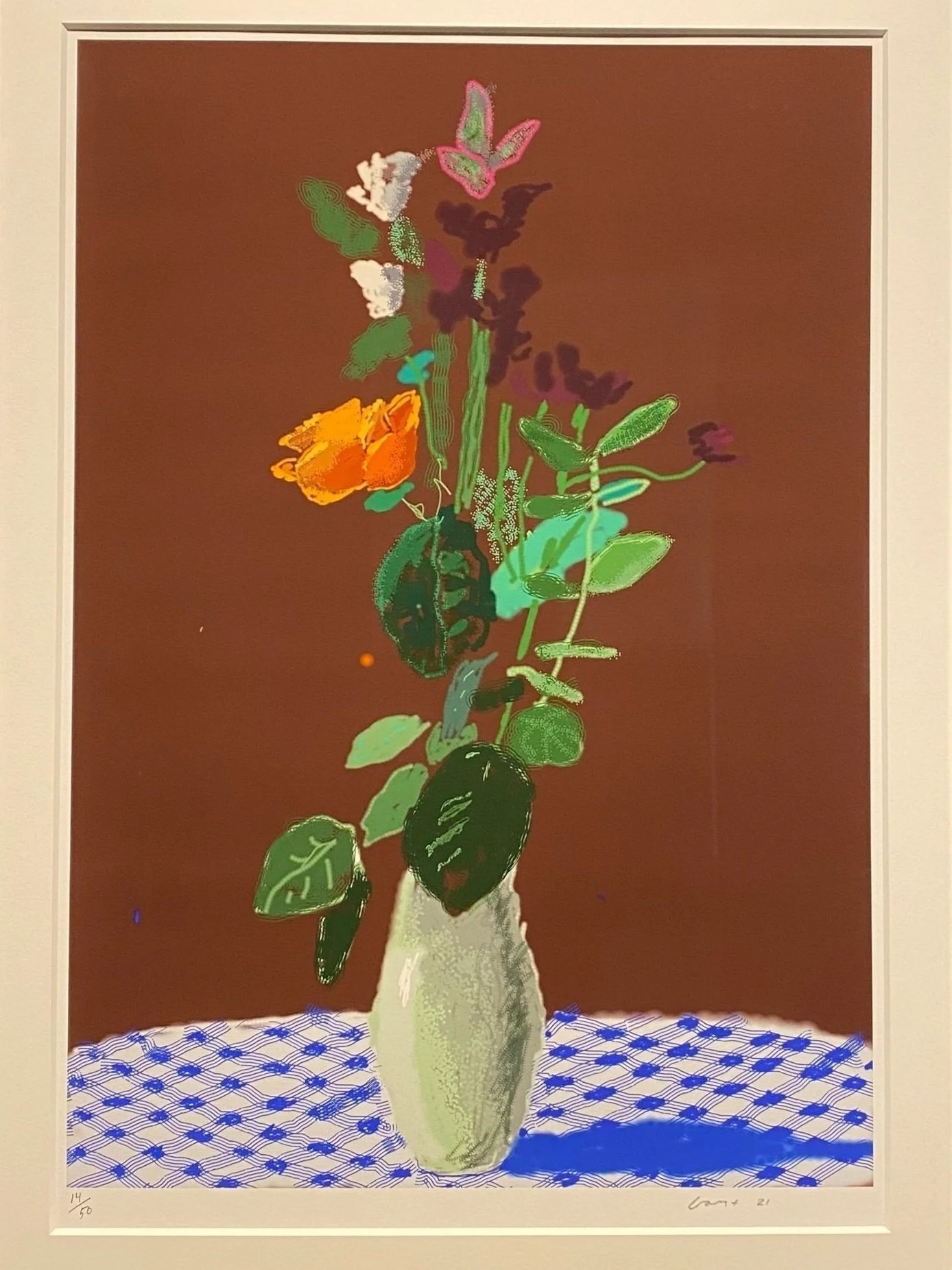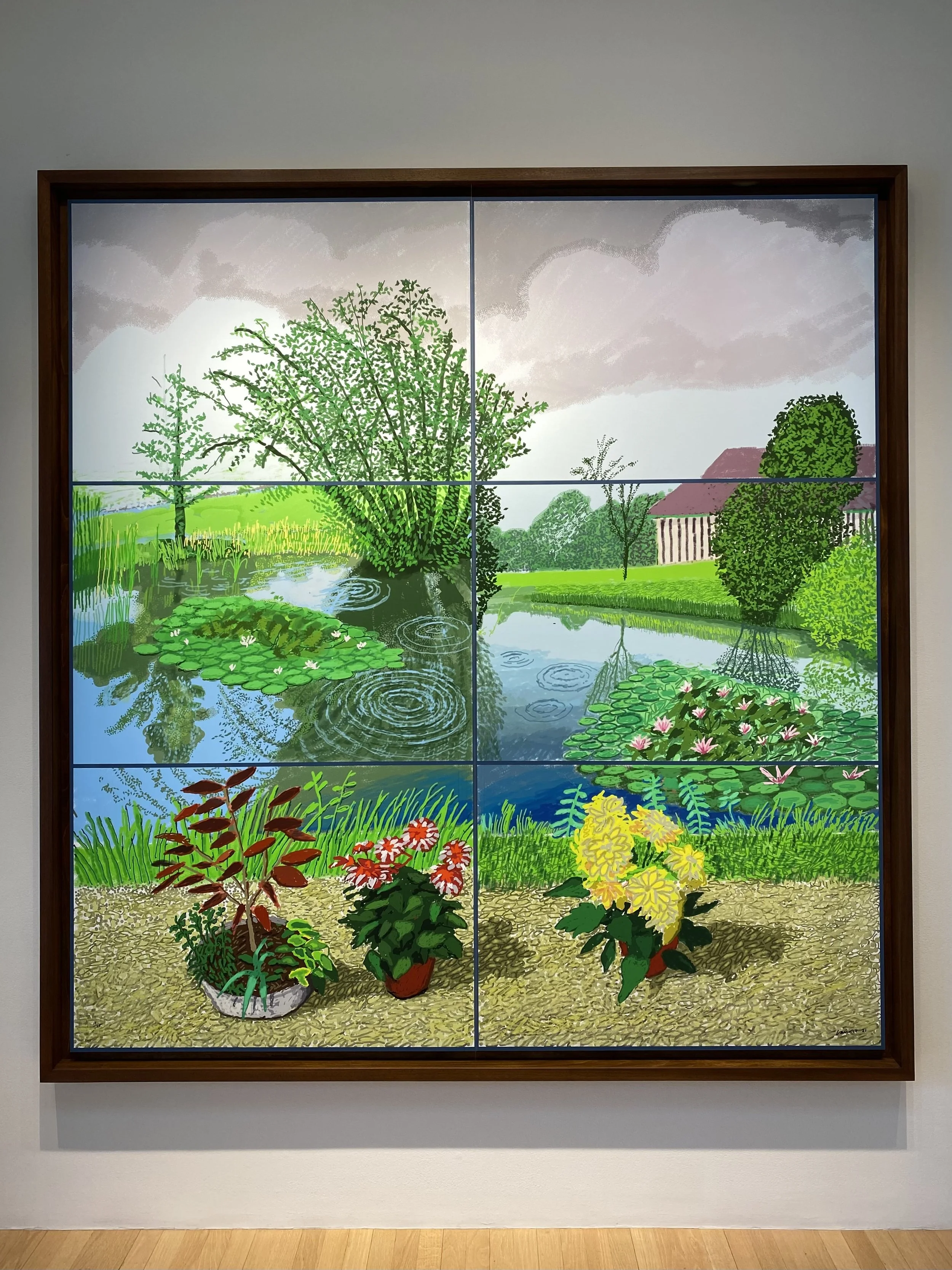Hockney’s rendezvous with Digital Painting
David Hockney, 25th June 2022, Looking at Flowers
David Hockney earned my admiration in 2018 when I saw his awe inspiring exhibition of eighty-two portraits at the Los Angeles County Museum of Art. To this day, it is the most impressive exhibition I have ever seen and since then I have been a Hockney fan. When I heard about his show at the LA Louver in Venice Beach, there was no doubt in my mind that I had to go despite the grueling rainy LA traffic.
Hockney is a British artist best known for his contributions to the Pop Art movement in the 1960s, his lurid depictions of Southern California culture (think swimming pools), and his portraits and landscapes. Now in his 80s, Hockney steps into digital art–a new yet familiar medium. Just like the rest of us, Hockney had some downtime in 2021 during the pandemic while living at his residence in Normandy, France and decided spend his days exploring digital drawing. This resulted in twenty still-life “iPad paintings” of vases of flowers and four plein air pieces.
7th March 2021, More Flowers on a Table
(Please note the stray orange dot in the middle of the painting—fascinating.)
I harbor complicated feelings about digital art. Just like with any art medium, the artist must translate an idea to an image. Sometimes this translation occurs through a paintbrush or some sort of construction. With digital painting, there is an extra layer of translation that happens when an image is drawn in Procreate or Photoshop–some sort of digitization that smoothes and pixelates or a brushstroke that is a setting rather than the fingerprint of the artist. This extra step in translation can flatten the human aspect of art that I find most endearing. As someone who gravitates towards tactile mediums and finds that even a paintbrush can be too much of a barrier, digital painting never quite made much sense to me. After taking a couple digital art studio and theory classes, I’ve come to respect the medium more but my hesitancy remains.
When I heard about this exhibition, I was a bit skeptical. Why would Hockney, a once in a generation painter, paint digitally? Is he desperately trying to keep up with the nascent technologies making their impact in art? Or, is he genuinely curious about the medium? In the exhibition, Hockney describes the iPad paintings as a type of printmaking and editions the pieces as if they are prints. It’s interesting to see an artist like Hockney navigate the digital art realm because he views it in a different lens. He never states which software or stylus he used. The pieces are simply “iPad paintings.” Part of me even doubts that he used an iPad.
Hockney approaches drawing the vases full of flowers very much like a seasoned painter rather than a digital artist. From a distance, they do look like oil paintings. He uses a motley of digital paint brush styles of varying thicknesses and opacities. I find the stray marks of color that Hockney leaves in the paintings to be humorous because they could have easily been deleted. The flowers are loose and Hockney’s paint paths are very visible and scribbly. At times, I missed the fluidity and dimensions of his brushstrokes in his oil paintings. Taking a step back, I can see that Hockney chose to focus more on color and shape for the flowers. It was a stylistic choice.
7th April 2021, Three Daffodils
in
a Bottle
When the flowers left me wanting, I found myself engrossed in Hockney’s treatment of the vases and tablecloths. Here, the utility of the preset paintbrushes shines. The painting of the daffodils in a bottle vase is a prime example. The sides are made up of a fuzzy, thick brush while Hockney uses delicate dots and lines elsewhere to create a glass-like effect. I am enamored by the distortion of the table cloth within the vase. On the table cloth, Hockney layers passes of a low opacity blue to create shadows. The more I look at the paintings, the more details and marks I notice.
In addition to the flowers, I greatly enjoyed his plein air digital paintings. Each of them were divided into panels which were painted separately and then assembled to create a larger piece. I was fascinated by the places where the paintings in the panel did not quite match up—almost like a glitch. Hockney also created a piece that featured all the flowers in the ornate frames he wanted them to be displayed in but due to qualms with the museums he could not. I thought that was a clever solution.
10th-22nd June 2021, Water Lilies in the Pond with Pots of Flowers
This series of flowers reminded me of Hockney’s series of portraits. I appreciated how the paintings were organized by date so that you can watch Hockney’s progression. For instance, the only day a chair appeared by the table was on the second day of the project. He must have not liked painting the chair so excluded it from the compositions going forward. I am still grappling with my relationship with digital art, but Hockney convinced me that it’s a medium worth revisiting. I will say that you have to see this exhibition in person to fully grasp its wonder. While the medium is new, the pieces are still very Hockney.
A couple days ago, I sat next to a posh British woman at the Palm Springs Festival. We got to chatting and she said that she was underwhelmed by Hockney’s flowers but thought the plein air pieces were wonderful. She also mentioned that she has a friend who sat for a portrait by Hockney and was very upset because she looked old in the painting (“She has a lined face but she doesn’t look 150 years old in person!”).
What a small world.



